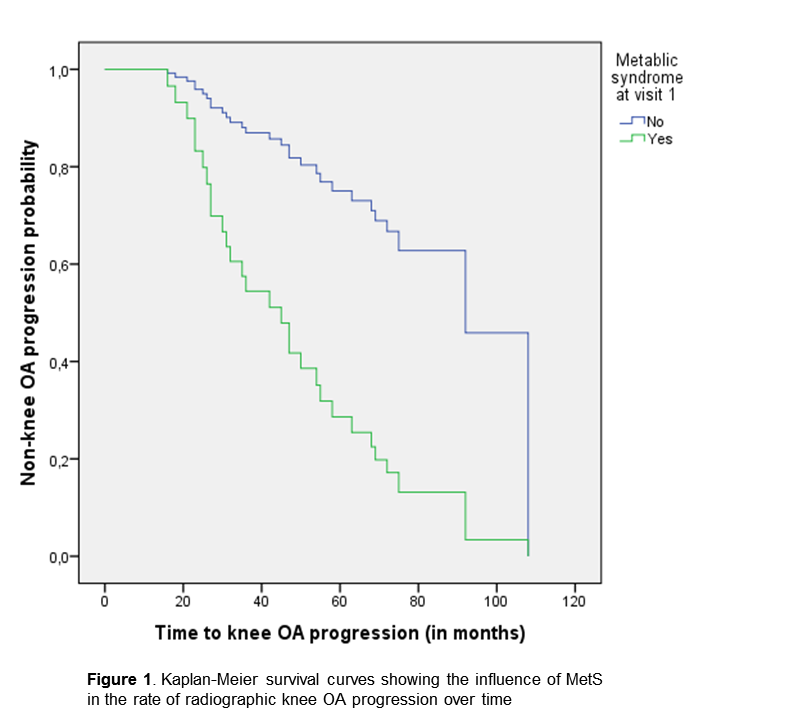Session Information
Date: Tuesday, November 7, 2017
Title: Osteoarthritis – Clinical Aspects Poster II: Observational and Epidemiological Studies
Session Type: ACR Poster Session C
Session Time: 9:00AM-11:00AM
Background/Purpose:
The contribution of metabolic factors in the development of OA has not been fully elucidated. The aim of this work is to analyze the influence of metabolic syndrome (MetS) in the rate of radiographic progression of knee osteoarthritis, as well as in the prevalence of radiographic hand OA.
Methods:
For this work we used data from the Spanish cohort PROCOAC (PROspective Cohort of OsteoArthritis A Coruña). This cohort consists of subjects that visited the Rheumatology consultations at different time points and comprises 984 subjects at baseline including radiographic knee and hip KL grade, radiographic hand OA status (129 of them with an erosive phenotype), demographic and clinical data as well as the necessary information to assess the MetS at baseline, that is, abdominal circumference (in cm) in addition to at least two of the following parameters: triglycerides above 200mg/dL, low HDL (<35 mg/dL), hypertension and glucose blood levels (>110 mg/dL). To assess the severity of the disease, the number of affected joints was coded as 0-1 and 2-3, according to the radiographic information of hands, knees and hips. Appropriate statistical analyses including regression models adjusting for the confounder variables of gender, age and BM, and chi-square contingency tables, were performed with SPSS v24.
Results:
MetS appeared as a significant risk factor (HR=2,651;95CI:1,224-5,744;p-value=0.0013) in those OA patients that experienced radiographic knee OA progression over time (any KL increase from KL>=2 at baseline) (Figure 1).
MetS is also a risk factor for OA occurrence if BMI is not taken into account (HR=1,716;95CI:1,069-2,754;p-value=0.025); however, when BMI is considered, the effect of MetS in OA is lost.
MetS was not associated with radiographic hand OA presence (HR=1,063;95CI:0,573-1.976;p-value=0,847). In relation to each of the components of MetS, only hypertension was borderline statistically significantly associated with radiographic hand OA (HR=1,584;95CI:0,986-2,546;p-value=0,057). When considered the subgroup of patients with the erosive phenotype, MetS significantly associates with an increased risk (HR=1,821;95CI:1,023-3,241;p-value=0,042)
In terms of severity, MetS associates with an increased number of affected joints (OR=1,735;95%CI=1,102-2,731;p=0.016).
Conclusion:
MetS condition the progression of knee osteoarthritis and is also a risk factor for erosive hand OA; however, its impact in the occurrence of the knee OA is dependent of BMI. The possible role played by hypertension in radiographic hand OA requires further investigation
To cite this abstract in AMA style:
Oreiro N, Fernandez Moreno M, Cortés-Pereira E, Vazquez Mosquera ME, Pertega S, Relaño-Fernandez S, Raga AC, Fernandez-Lopez C, Rego-Pérez I, Blanco FJ. Metabolic Syndrome Influences the Radiographic Progression of Knee Osteoarthritis and Condition the Risk of Erosive Hand OA [abstract]. Arthritis Rheumatol. 2017; 69 (suppl 10). https://acrabstracts.org/abstract/metabolic-syndrome-influences-the-radiographic-progression-of-knee-osteoarthritis-and-condition-the-risk-of-erosive-hand-oa/. Accessed .« Back to 2017 ACR/ARHP Annual Meeting
ACR Meeting Abstracts - https://acrabstracts.org/abstract/metabolic-syndrome-influences-the-radiographic-progression-of-knee-osteoarthritis-and-condition-the-risk-of-erosive-hand-oa/

